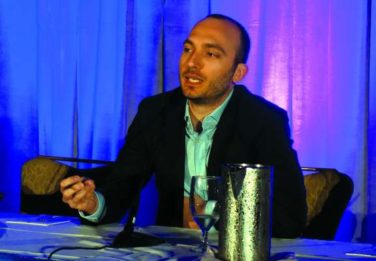FROM THE AACR ANNUAL MEETING
The human papillomavirus vaccine may afford protection to some women with prior HPV exposure, based on the results of a post-hoc analysis of the HPV Vaccine Trial in Costa Rica.
At the 4-year follow-up visit, multi-site efficacy against HPV16/18 DNA at the cervical, anal, or oral region was, as expected, the strongest at 84% among HPV-naive women who received the vaccine, but significant multi-site efficacy of 58% also was seen among women with evidence of HPV exposure prior to vaccination. Vaccine efficacy was nonsignificant at 25% in women with active cervical infection at vaccination, indicating that the vaccine is not therapeutic, study author Daniel C. Beachler, Ph.D., reported at the annual meeting of the American Association for Cancer Research.
The findings support current U.S. guidelines from the Centers for Disease Control and Prevention recommending routine vaccination for those aged 11-12 years, and vaccination through age 26 for those not previously vaccinated. HPV vaccination is known to be highly effective at cervical, anal, and oral regions in HPV-naive individuals and to have reduced impact in women aged 18-25.
What’s unknown is the combined multi-site vaccine efficacy on an individual basis, and whether HPV vaccine protects noninfected sites against HPV infection, Dr. Beachler , a postdoctoral fellow in the Infections and Immunoepidemiology Branch of the National Cancer Institute, said.
The phase III, National Cancer Institute HPV Vaccine Trial in Costa Rica enrolled 7,466 women, aged 18-25 years, over 6 months and randomly assigned them to one of three doses of the HPV16/18 vaccine (Cervarix) or to a hepatitis A vaccine (Havrix). Cervical samples were collected at every annual visit. Oral and anal samples were collected at only the 4-year follow-up visit. A total of 4,186 women contributed samples for all three sites and were included in the analysis.
Samples were tested for alpha mucosal HPV DNA types utilizing the SPF10 PCR-DEIA-LiPA25 system , version 1. An HPV event was defined as a woman with prevalent HPV16/18 DNA at the cervical, anal, or oral regions.
HPV naive was defined as HPV 16/18 seronegative and cervical HPV 16/18 DNA negative, prior infection was defined as HPV 16/18 antibody positive and cervical HPV 16/18 DNA negative, and active infection was defined as cervical HPV16/18 DNA positive.
Among all 4,186 women, multi-site vaccine efficacy at the 4-year visit was 65%, Dr. Beachler said.
HPV vaccinated women had fewer concordant infections, with vaccine efficacy reaching 91% for protection of at least two or three sites.
Indeed, only 7% of HPV 16/18-infected women in the vaccine arm had that same HPV type at two or more anatomic sites, compared with 30% of HPV 16/18-infected women in the control arm (P value < .01), again “giving support that the vaccine may provide some protection against uninfected sites in previously exposed women,” Dr. Beachler said.
He pointed out that the one-time sampling of oral and anal HPV and misclassification in assays could have affected the results. If complete information were available, vaccine efficacy would likely have been closer to 100% in the HPV-naive subgroup, he said.
Follow-up is continuing in the trial to determine the duration of protection, but there is still strong evidence of protection at 9 years, suggesting a booster dose is not necessary, Dr. Beachler said.
Further research of HPV infection outside the cervix, however, is very much needed.
“We know that only a certain percentage, 60%-70% of people who are infected, actually develop a serological response. We don’t even really know if an oral HPV infection or an anal HPV infection produces a serological response. We really need to understand HPV outside the cervix,” he said.
The National Cancer Institute funded the study. GlaxoSmithKline provided vaccines and support for regulatory aspects of the trial. Dr. Beachler declared no financial disclosures.
On Twitter @pwendl



